The Economics and Statistics Division maintains archives of previous publications for accountability purposes, but makes no updates to keep these documents current with the latest data revisions from Statistics Canada. As a result, information in older documents may not be accurate. Please exercise caution when referring to older documents. For the latest information and historical data, please contact the individual listed to the right.
<--- Return to Archive
For additional information relating to this article, please contact:
February 11, 2022HOURS WORKED AND LABOUR PRODUCTIVITY, 2020 [REVISED] Statistics Canada has released revised labour productivity accounts for 2020. The data are consistent with provincial and territorial economic accounts and GDP by industry data released in November 2021. The revision also incorporate revisions from the Survey of Employment, Payroll and hours as well as the Labour Force Survey. Data reported below focus on business sector industries and do not include either government or non-profit institutions (for example, education refers only to private educational institutions and not government-funded schools).
During 2020, the imposition of widespread restrictions to contain the COVID-19 pandemic resulted in significant declines in hours worked in every province as well as in most business industries. However, the decline in real GDP from business sector industries was much lower than the drop in hours worked - raising productivity in all provinces.
Nova Scotia's business sector labour productivity increased by 11.2% in 2020, revised up from 9.8%. National productivity was up 7.8% with strong gains in all provinces. Newfoundland and Labrador reported the largest gains in labour productivity while Manitoba reported the slowest increase.
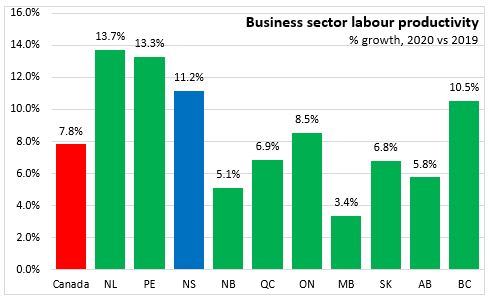
Labour productivity represents the amount of real value added generated per hour worked. Nova Scotia's business sector labour productivity was $44.8 in real value added per hour worked in 2020. National business sector labour productivity was $62.0 in real value added per hour worked. Labour productivity is considerably higher in resource-producing provinces (Newfoundland and Labrador, Saskatchewan, Alberta) as these industries generate large amounts of real value added with comparatively few hours worked. Labour productivity was lower in all three Maritime provinces.
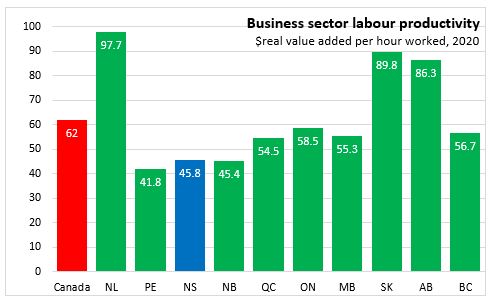
With the imposition of COVID-19 restrictions, hours worked fell by 13.4% across all Nova Scotia business sector jobs in 2020 (unchanged from preliminary results). This was similar to the national decline (-13.4%). Newfoundland and Labrador reported the largest drop in hours worked while New Brunswick and Manitoba reported the smallest declines.
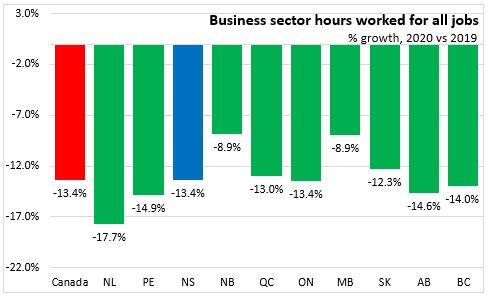
Despite declining hours worked, the fall in real value added was substantially smaller in every province. Nova Scotia's business sector real value added fell by 3.7% (previously 4.9%). National business sector value added fell by 6.5% with the largest fall in Alberta. Prince Edward Island and Nova Scotia reported the smallest declines in business sector value added.
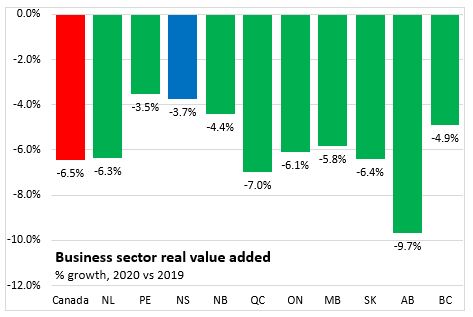
Labour productivity represents the difference between changes in hours worked and changes in real value added. Real value added can be approximated as the sum of changes in hours worked and changes in labour productivity (plus an interaction term that reflects the product of changes hours worked and changes in labour productivity).
Nova Scotia's labour productivity gain of 11.2% offset a 13.4% drop in hours worked (with a 1.5% interaction) to generate a 3.7% fall in business sector real value added.
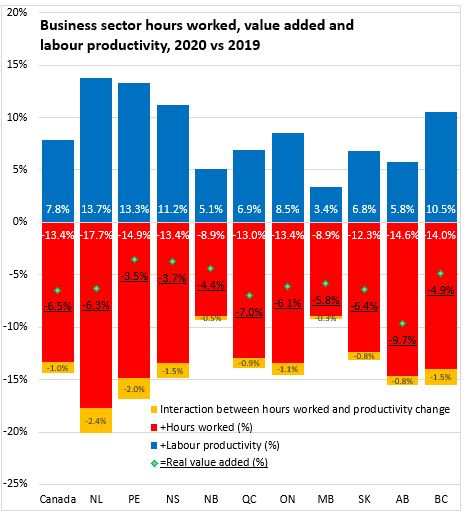
Pandemic-related restrictions were different across many business sector industries in the Nova Scotia economy. Most business sector industries reported lower hours worked (except mining and quarrying). For most industries, reductions in hours worked were partially offset by gains in productivity. Rising productivity limited the reduction in real output despite reduced labour input.
There were exceptions. In arts, entertainment and recreation; accommodation and food services; administration and business support; and transportation there were sharp reductions in hours worked as well as declines in productivity. Arts, entertainment and recreation as well as accommodation and food services reported the largest declines in real value added. These two industries were among the most restricted in 2020 due to the high-contact nature of their operations.
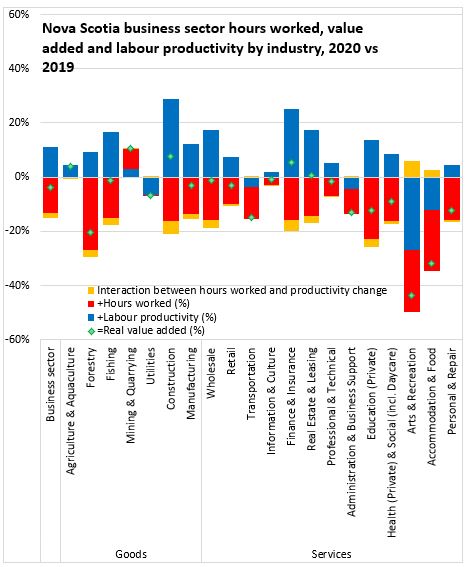
Productivity growth was stronger than the national average for Nova Scotia's goods industries as well as for service industries. However, both goods and services sectors in Nova Scotia have below-average productivity.
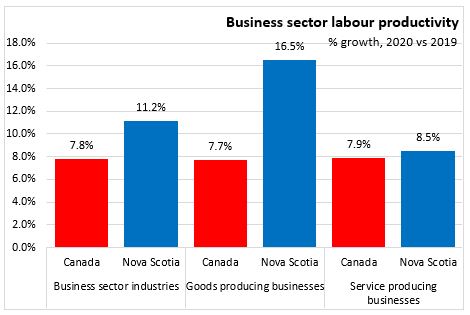
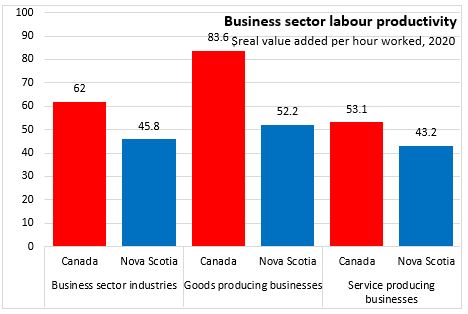
The rise in Nova Scotia's business sector labour productivity in 2020 is mostly associated with the shock to hours worked during pandemic-related restrictions. Productivity changes in 2020 were substantially different from previous trends.
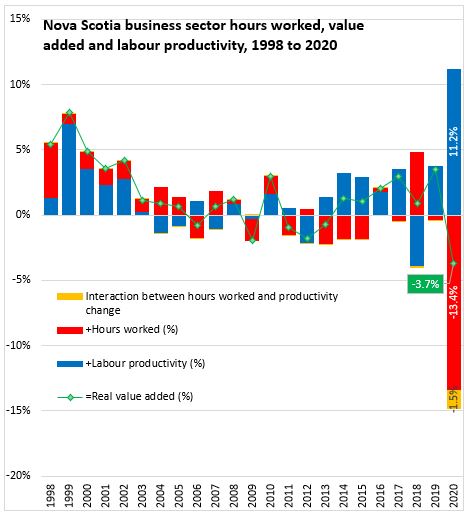
Unit labour costs measure the amount of labour compensation required to generate $1 of real value added. With the reduction in hours worked concentrated in industries with lower-paid employees, there was a substantial rise in employee compensation paid per hour worked (higher-paid employees were more likely to be able to work from home with less reductions in hours worked).
Business sector employee compensation per hour worked rose by 14.7% in Nova Scotia in 2020, the highest among the provinces. National employee compensation increased by 11.6%. The smallest gain was observed in New Brunswick. Business sector employee compensation averaged $32.80 per hour in Nova Scotia and $39.74 in Canada in 2020.
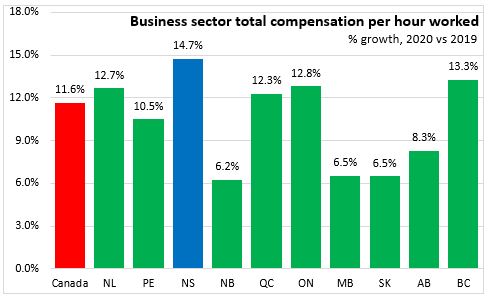
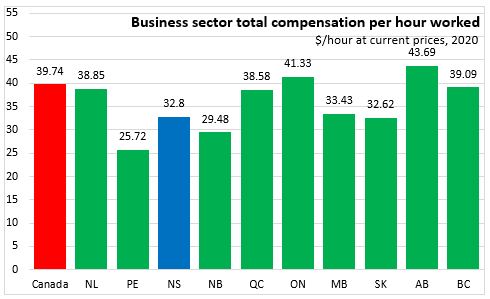
In 2020, rising employee compensation per hour worked was only partially offset by increasing productivity. Unit labour costs increased by 3.3% in Nova Scotia and 3.4% nationally. Unit labour costs increased the most in Quebec and declined by the most in Prince Edward Island.
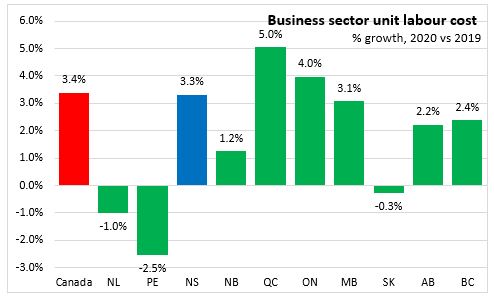
Business sector unit labour costs were $0.716 per $1 of real value added in Nova Scotia. The highest among the provinces in 2020. National unit labour costs were $0.641 per $1 of real value added. The lowest unit labour costs were reported in resource-producing provinces (Saskatchewan, Newfoundland and Labrador and Alberta) reflecting the relatively low labour intensity of resource production.
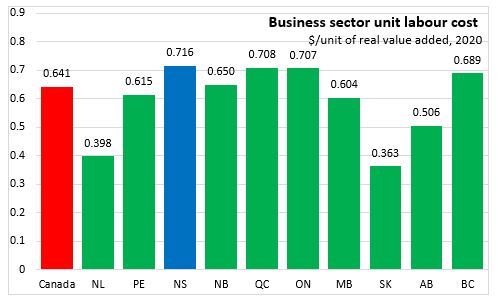
Source: Statistics Canada. Table 36-10-0480-01 Labour productivity and related measures by business sector industry and by non-commercial activity consistent with the industry accounts
<--- Return to Archive